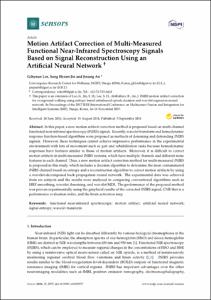Full metadata record
| DC Field | Value | Language |
|---|---|---|
| dc.contributor.author | Lee, Gihyoun | - |
| dc.contributor.author | Jin, Sang Hyeon | - |
| dc.contributor.author | An, Jinung | - |
| dc.date.accessioned | 2018-10-11T02:02:56Z | - |
| dc.date.available | 2018-10-11T02:02:56Z | - |
| dc.date.created | 2018-10-04 | - |
| dc.date.issued | 2018-09 | - |
| dc.identifier.issn | 1424-8220 | - |
| dc.identifier.uri | http://hdl.handle.net/20.500.11750/9340 | - |
| dc.description.abstract | In this paper, a new motion artifact correction method is proposed based on multi-channel functional near-infrared spectroscopy (fNIRS) signals. Recently, wavelet transform and hemodynamic response function-based algorithms were proposed as methods of denoising and detrending fNIRS signals. However, these techniques cannot achieve impressive performance in the experimental environment with lots of movement such as gait and rehabilitation tasks because hemodynamic responses have features similar to those of motion artifacts. Moreover, it is difficult to correct motion artifacts in multi-measured fNIRS systems, which have multiple channels and different noise features in each channel. Thus, a new motion artifact correction method for multi-measured fNIRS is proposed in this study, which includes a decision algorithm to determine the most contaminated fNIRS channel based on entropy and a reconstruction algorithm to correct motion artifacts by using a wavelet-decomposed back-propagation neural network. The experimental data was achieved from six subjects and the results were analyzed in comparing conventional algorithms such as HRF smoothing, wavelet denoising, and wavelet MDL. The performance of the proposed method was proven experimentally using the graphical results of the corrected fNIRS signal, CNR that is a performance evaluation index, and the brain activation map. © 2018 by the authors. Licensee MDPI, Basel, Switzerland. | - |
| dc.language | English | - |
| dc.publisher | Multidisciplinary Digital Publishing Institute (MDPI) | - |
| dc.title | Motion artifact correction of multi-measured functional near-infrared spectroscopy signals based on signal reconstruction using an artificial neural network | - |
| dc.type | Article | - |
| dc.identifier.doi | 10.3390/s18092957 | - |
| dc.identifier.scopusid | 2-s2.0-85053075867 | - |
| dc.identifier.bibliographicCitation | Sensors, v.18, no.9, pp.1 - 16 | - |
| dc.description.isOpenAccess | TRUE | - |
| dc.subject.keywordAuthor | functional near-infrared spectroscopy | - |
| dc.subject.keywordAuthor | motion artifact | - |
| dc.subject.keywordAuthor | artificial neural network | - |
| dc.subject.keywordAuthor | signal entropy | - |
| dc.subject.keywordAuthor | wavelet transform | - |
| dc.subject.keywordPlus | WAVELET SHRINKAGE | - |
| dc.subject.keywordPlus | CEREBRAL-BLOOD | - |
| dc.subject.keywordPlus | NIRS | - |
| dc.subject.keywordPlus | FMRI | - |
| dc.subject.keywordPlus | GAIT | - |
| dc.subject.keywordPlus | IMPROVEMENT | - |
| dc.subject.keywordPlus | ACTIVATION | - |
| dc.subject.keywordPlus | RESPONSES | - |
| dc.subject.keywordPlus | STROKE | - |
| dc.subject.keywordPlus | MRI | - |
| dc.citation.endPage | 16 | - |
| dc.citation.number | 9 | - |
| dc.citation.startPage | 1 | - |
| dc.citation.title | Sensors | - |
| dc.citation.volume | 18 | - |
- Files in This Item:
-
 기타 데이터 / 6.35 MB / Adobe PDF
download
기타 데이터 / 6.35 MB / Adobe PDF
download



